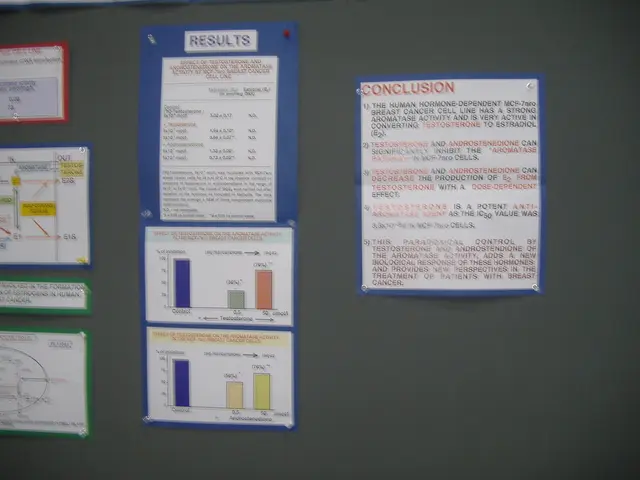Historic Wealth-Boosting and Debt-Reduction Act: Legislative Measure for Remarkable Wealth and National Debt Decrease
The One Big Beautiful Bill (OBBB) Act, a comprehensive economic policy package, is projected to have significant impacts on the American economy. The Council of Economic Advisers (CEA) has analyzed the economic and fiscal impact of the OBBB, following their report on President Trump's proposed tax cuts in May 2025.
Economic Impact
The OBBB includes provisions such as full expensing for machinery, equipment, and research & development, which are forecasted to raise investment by more than $600 billion over ten years. This encourages businesses to invest more in capital and innovation, leading to increased economic growth.
The Tax Foundation estimates the OBBB will create approximately 938,000 full-time equivalent jobs nationwide in the long run, with substantial gains in large states like California (132,000 jobs) and Texas (81,000 jobs). Lower inflation and tax cuts also bolster economic growth, contributing to a blue-collar wage boom.
The Act aims to fuel higher wages particularly for middle-class and blue-collar workers, driven by historic tax cuts and investments. Although exact wage growth figures are not detailed, the job creation and investment surge point to wage increases.
Fiscal Impact
The OBBB results in a net deficit increase of about $800 billion when considering all tax cuts and revenue provisions. This includes sizeable costs from tax cuts for businesses, no tax on tips and overtime, and estate tax relief totaling over $800 billion.
To offset part of the new tax cuts and limit deficit growth, the Act enacts roughly $1.1 trillion in spending reductions, primarily from Medicaid, SNAP reforms, and student loan adjustments. This helps reduce the overall net increase in the deficit.
Many tax relief provisions are temporary, expiring after 2028, which affects the medium-term fiscal outlook.
Distributional and Household Effects
While the average taxpayer will see a tax cut of about $3,752 in 2026, distributional effects vary. The bottom 10% of households are projected to face average income reductions of 7%, whereas the top 10% experience a 1.5% increase in after-tax income when combined with 2025 tariff changes. This suggests the benefits of the OBBB are somewhat regressive across income groups.
Most individual tax brackets remain unchanged but are now made permanent with inflation adjustments; seniors receive an enhanced standard deduction to reduce their taxable income.
Summary
In the early years (beginning 2026), average taxpayers benefit from tangible tax cuts and employment gains. Over ten years, investment incentives and spending cuts combine to moderate but not fully offset the large fiscal cost, resulting in a net deficit increase of approximately $800 billion.
Job creation nears one million full-time equivalent jobs, with increased investment supporting economic growth and wage gains in the middle class. The CEA projects 6.9 to 7.2 million full-time equivalent jobs protected and created in the first four years of OBBB implementation.
The OBBB Act spurs economic growth and job creation by cutting taxes and encouraging investment while aiming to limit deficit growth through spending reforms. However, the overall fiscal impact is a moderate increase in the deficit over ten years, and income benefits may be concentrated disproportionately towards higher earners.
On May 22, 2025, the House of Representatives passed H.R.1, the One Big Beautiful Bill (OBBB) Act. The Senate Finance Committee released the OBBB text on June 16, 2025. The CEA's analysis shows how the OBBB impacts the trajectory of deficits and debt relative to GDP, and it projects $2.1 to $2.3 trillion in offsetting deficit reduction due to higher growth from the OBBB tax provisions over the ten-year budget window. The CEA forecasts $7,600 to $10,900 higher annual after-tax take-home pay for a typical family with two children in the first four years of OBBB implementation, and $4,000 to $7,200 higher annual real wages per worker. The OBBB aims to avert a $4 trillion tax hike from the expiration of the 2017 Tax Cuts and Jobs Act (TCJA).
- The OBBB's projected job creation of 938,000 full-time equivalent jobs across the nation, bolstered by investment incentives, is expected to contribute to growth in the American business sector.
- The Act's provisions, such as tax cuts and spending reductions related to Medicaid and student loans, fall under the broader category of policy-and-legislation, with implications for both the American economy and politics.
- The increase in the deficit of around $800 billion, resulting from the OBBB's tax cuts and revenue provisions, has implications for the overall fiscal health of the American government, with potential impacts on the country's long-term economic stability and general news headlines.




